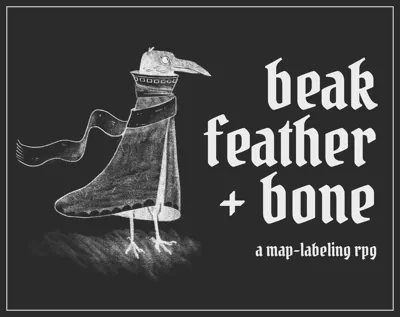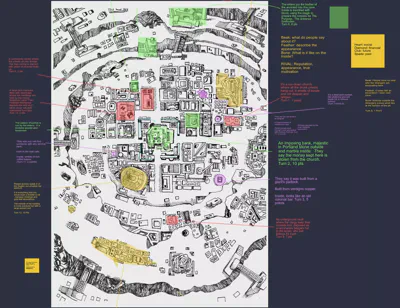Finally got around to playing this! The description from the website is better than I could write.
Beak, Feather, & Bone is a collaborative worldbuilding tool as well as a competitive map-labeling RPG. Starting with an unlabeled city map, players are assigned community roles before taking turns claiming and describing locations. Players draw from a standard 52-card deck to determine a building’s purpose and then describe its beak (reputation), feather (appearance), and bone (interior). As buildings are claimed, a narrative for the town and its inhabitants emerges, including major NPCs and shifting power-dynamics.
It’s designed to be played in person, but I’m still playing online1. Unlike The Quiet Year, it does not encourage playing in silence, and the map is already drawn. There’s also no events occurring, any timeline would grow from natural RP.

Tools
As this is such a simple game, I tried to not default to Foundry. The card support is (in theory) about to be replaced in the next major version2, and the current module requires the GM to do a lot of poking. Instead I used:
- Owlbear Rodeo, a light VTT
- Roll For Your Party, a dice and deck wrangling system
They both work by one person visiting the website, getting a session URL, and sharing it with the party. It seems that everything is then shared peer-to-peer between users’ web browsers. This led me to my first surprise, my browser uploaded the map (slowly!!) to each person’s browser in my party before they could see what was going on.
Roll For Your Party did Just Work. Until it didn’t, and one player couldn’t see a drawn card until they manually reloaded. It wasn’t the end of the world, but it didn’t really save much effort over a discord bot3.
Game
Four of us played this online for a little over an hour. The first round was a little slower as it included explaining the rules. At the end of it, we had the following map:

There’s some really nice things to take from this, even over The Quiet Year:
- It’s really simple - draw a card as a prompt, pick a building and talk about it
- You can stop whenever you want, so it can fill a session of any length. The Quiet Year needs some specific massage to manage that, certain events need to happen, and a game that’s too short doesn’t have much conflict.
- The artwork is lovely, look at those birdfolk!
However, we basically stopped playing well before the session finished. The prompts for the purposes of the buildings are:
- Finance
- Social
- Past
- Future
And that’s it. We just couldn’t think of new buildings to add that weren’t repetitious once we’d done a dozen or so. If you draw a finance option again and you’ve got a bank and a souk and a tomb of treasure, then our party at least were really struggling.
We also dropped the terms beak, feather, and bone as nobody could remember what they meant. So the game rapidly became the Top Trumps of reputation, appearance, and interior. I’d like to think this wouldn’t happen with a physical game that has many more pictures of birdfolk; but the wings didn’t really stay with us much. Our story was reasonably generic.
The next problem we had was what to do with the descriptions of the buildings. Do we keep them somewhere? Writing them on the map took a while; to be fair, it’s not required in the rules. We changed to writing your notes while the next player draws a card and has a think.
Lessons
- Owlbear Rodeo is nice and easy to set up.
- But make sure any assets you use are small, if your Internet upload is slow.
- Not great for communal notes either
- I probably wouldn’t use Roll For Your Party again in this use case, I’d just draw and tell people.
- I will save Beak, Feather, & Bone to play again in person, without the booklet it loses too much. I prefer The Quiet Year.